Bruges is a popular visit on the cruise ship Northern European circuit and is easily accessed from the port of Zeebrugge. See…
…for the definitive way to get to Bruges from Zeebrugge.
Assuming arrival at Bruges railway station there is a very pleasant walk (I followed the blue route)…

…along cobbled streets, past gabled homes all built in typical Flemish architecture…

…until reaching St. Salvatores Cathedral…

St.Salvatores Cathedral, the main church of the city, is one of the few buildings in Bruges that have survived the onslaught of the ages without damage. It also boasts a rather quirky modern art ‘window’ exhibition on the courtyard adjacent Steenstraat…

A short walk along Steenstraat will take the visitor to the city’s central Markt (Market Square). This is the heart of the city and a veritable tourist hot spot with two sides lined with cafes and restaurants…

On one side of the ‘Markt’ lies the Belfort, or Belfry…
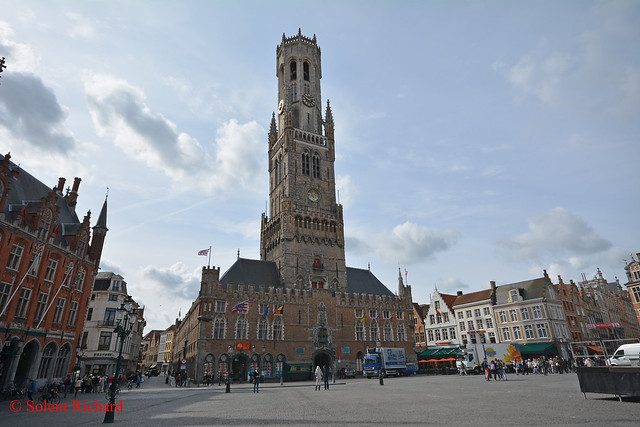
…while to the east of the Markt is the ornate Provincial Government Palace and Central Post Office…

Central to Markt is the statue of Jan Breydel and Pieter de Coninck, the leaders of the Bruges Matin and heroes of the ‘Battle of the Golden Spurs’ against the French in 1302…

The Markt is a central starting point for the well favoured horse drawn carriage rides…

It is popular with tourists to climb the Belfort Tower and that is exactly what Solent Richard had set his sights on…

Indeed, it was actually my prime target and needless to say I was first in the queue when it opened at 9.30. The number of visitors in the tower is limited at any one given time, hence I was keen to be there early. The entrance charge is €6.00.
The current construction dates back to 1240. A narrow, steep staircase of 366 steps…

…leads to the top of the 83-metre-high building, which leans about a metre to the east. Having reached the top first, I was mighty pleased when a fellow climber arrived and we photographed each other r next to the 6 tonne Great Bell…

The climb passes through the ‘Drum Room’ which was of particular interest…

*****
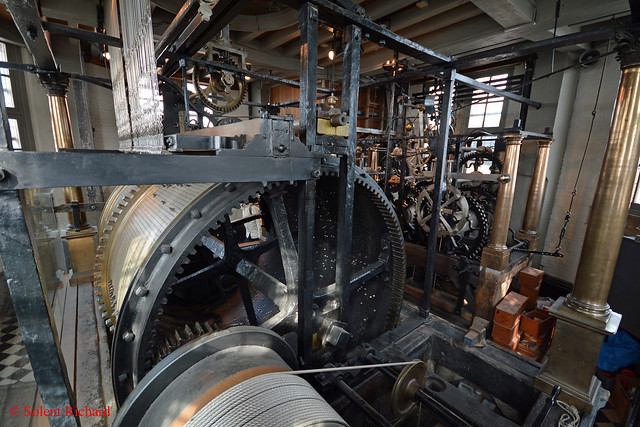
*****

Above the viewing platform housing the 6 tonne great bell is a variety of smaller bells and the 47 piece carillon. They peel every 15 minutes and being there for at least one peel is another great experience…
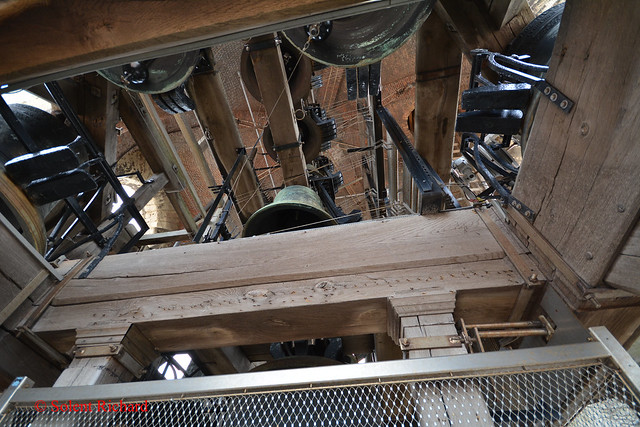
And the views from the Belfry over the Provincial Government Palace...

The rest of the Markt...

…and my next destination, The Burg and Basilica of the Holy Blood…
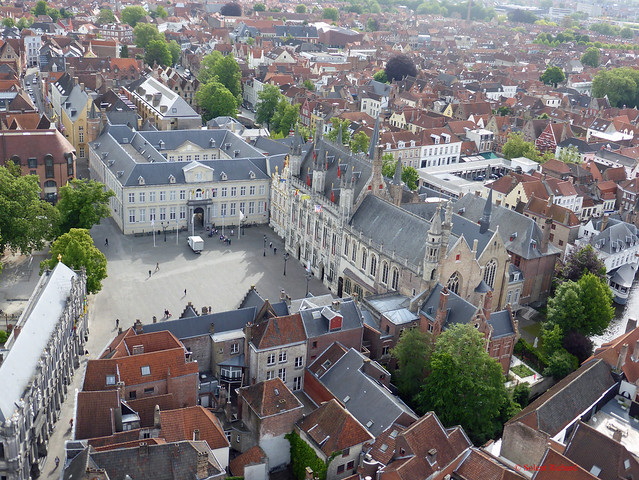
I can certainly vouch for the fact that the descent from the Belfry was seriously easier than the climb.
Next up is what I will call part two of my day in Bruges. Here is the route I took, from the Markt to The Church of Our Lady...

Turning East off the Grote Markt along Breidelstraat, the visitor will pass the Bruges Beer Museum…

*****

…before reaching The Burg…

The ‘Burg‘ is the second most important square in Bruges. It is also a showcase of different European architectural styles. It was, and remains, the heart of the administrative Bruges. One of the most beautiful buildings of Bruges can be seen here, the Gothic Stadhuis – Town Hall – which dates back to 1376.
Three other landmark buildings are also on The Burg: the Basilica of the Holy Blood, the Renaissance style Old Civil Registry dating from 1537 and the former Court of Justice (Bruges Vrije) in neo-classicist style dating back to 1727.
Over in the far right corner is the entrance to the Basilica of the Holy Blood…

Entrance to the Chapel of the Basilica is free…
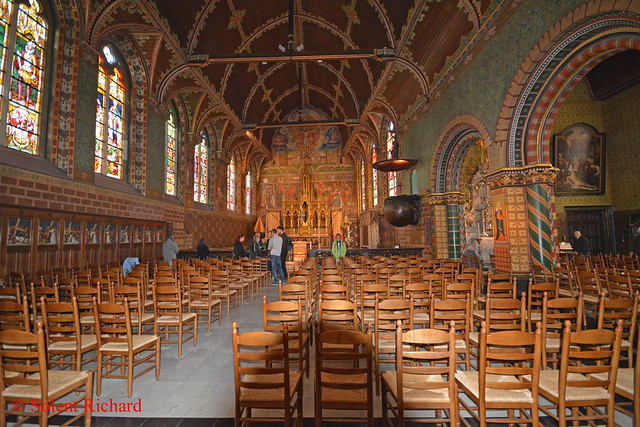
…though a small charge is made for admission to The Treasury Museum…

It is well worth a visit.
The second building of interest on The Burg is the Stadhuis (Town Hall)…

…and next to it,the Old Civil Registry…

The final piece in the Burg jigsaw is the Bruges Vrije Castellany…

It was here that the civil and ecclesiastical governing and administrative body of the Bruges district, (or Castellany) was located.
Leaving the Burg via the narrow lane between the Old Civil Registry and the Stadhuis leads to the start of what became my canal walk.
Just as the horse and carriage is a recognised tourist attraction in Bruges, so is a boat ride along the canal system…

A 30 minute canal boat ride costs €8.00…

I chose to follow the canal line and literally just around the corner from the above point reached probably one of the most photographed locations in Bruges, the Rozenhoedkaai…

I even recruited another passing photographer for a ‘swapsie’…

Continuing along Rozenhoedkaai one comes to a bridge over the Dijiver that effectively leads to Woolestraat. On that bridge is an interesting statue. It is of Saint John Nepomuk…

… who was a Czech a priest from Prague who, at the behest of King Wenceslaus of Bohemia was thrown from the Charles Bridge in Prague and drowned because he refused to reveal a confession to a jealous husband who suspected his wife of cheating on him. Most specific to the statue is a halo of five stars, commemorating the stars that hovered over the Vltava River on the night of his murder and it is said that the five stars also symbolize the five letters of Latin word “tacet”, which means “silent”.
Saint John Nepomuk is the Patron Saint of Bridges.
Continuing along the Dijiver the visitor can spot some interesting and humorous sites, like this antique and curios market building…

At the end of this section of the canal was a good view of my next two stops, the Museum Arentshuis and the Church of Our Lady…

To the rear of the Arentshuis Museum is the Arentshof.
In the garden of this 18th century abode are The Four Horseman of the Apocalypse in bronze by Rik Poot, an interesting group sculture representing famine, death, revolution and plague. A cheery topic but worth seeing. Here are two of them…

*****

Passing through the garden leads to the Church of Our Lady...

Dating mainly from the 13th, 14th and 15th centuries its tower, at 122.3 meters in height, remains the tallest structure in the city and the second tallest brickwork tower in the world.
Entrance is free and while there are many artefacts to see, including a white marble sculpture of the Madonna and child by Michelangelo, the item that really caught my eye was this magnificently decorated pulpit…

The final section covers my walk from the Church of Our lady and return to the Market…

A stones throw, effectively just across the road, from the Church of Our Lady is Old St. John’s Hospital…

St John’s Hospital is another one of those most photographed locations in Bruges. Dating back to the 11th-century it is one of Europe’s oldest surviving hospital buildings.The hospital grew during the Middle Ages and was a place where sick pilgrims and travellers were cared for. The museum building allows self-guided tours depicting the origin of religious hospitals and the evolution of medicine from the barbers to the surgeons to the midwives and then back in the hands of the doctors again. An entrance fee of €8.00 is charged.
Staying as close to the canal line as is possible I now made my way to Wijngaardplaats…

essentially a square and stopping point for the tourist horse drawn carriages to make a watering stop…

*****

…as their passengers cross this bridge to visit the ‘Princely Beguinage’…

The Princely Béguinage Ten Wijngaerde is the only preserved beguinage in Bruges. Since 1927 it has functioned as a convent for Benedictines.
Come on in and take a look…

The houses to the west side formed part of the Monasterium De Wijngaard, a priory of Benedictine nuns.
Silence is observed throughout the Béguinage and the peace and quiet was fascinating. Even groups of tourists with guides strained to listen to their guides’ whispers.
Something else however was going on in the Béguinage. ..

Art in progress? Tree huts actually…

My next stop was courtesy of a stroke of luck. I was heading away from Wijngaardplaats along Wingaardstraat when my attention was drawn to a group of tourists with a guide in a side street. Curiosity got the better of me and I walked along Noordstraat for some 200 yards. My curiosity was rewarded when I discovered that here was Almshouse de Vos Noordstraat…..

Almshouse de Vos Noordstraat is one of a number of Almshouses in Bruges built either by the Traders’ Guilds, or wealthy families, to provide homes for the poor people who in return would pray for them every day.
Almshouse de Vos, built in 1713, is a fine example of both an almshouse and Flemish medieval-style architecture consisting of four almshouses and a chapel surrounded by a traditional garden.
My return route to the Grote Markt took me once again past the Church of Our Lady and along Gruuthusestraat and the outer buildings of the Gruuthusemuseum…

Imagine my initial delight when I spotted the name ‘Guido‘ on a nearby statue…

Alas not my political blogging hero Guido Fawkes but an influential Belgian poet and writer.
I then retraced my steps along the canal to the bridge over the Dijiver where I previously found the statue of Saint John Nepomuk.
Crossing the bridge and walking along Woolestraat in the direction of the Belfort…

I came across this entrance to a bar…

Follow me in…

The wall of beer is truly incredible. There is a walkway at the end of which is a nice courtyard area to sit and sample a beer or two as well as the view…

Sample tray with 4 beer tasters and some nibbles for 10 euros seemed pretty fair.
For the final part of my Bruges day, the walk back to the railway station, I refer back to the first street map, this time the red route…

Leaving the Grote Markt via Steenstraat as far as St. Salvatores Cathedral and bear right along Zuidzardstraat to the square called Het Zand. This wide open square cannot be missed.
At the center of Het Zand square is a fountain with four groups of statues. The sculptures depict scenes from the history of Bruges: the group with the ladies, the four Flemish cities of Bruges, Antwerp, Ghent and Kortrijk…

The second group, with the sailor and the fish indicates the historical connection of Bruges through the ages had with the sea. A third group symbolizes the Flemish polder landscape….

And finally cyclists, accompanied by the Flemish folk heroes Nele and Till Eulenspigel…

From the Het Zand Square to the railway station is a 15 minute walk through the Koning Albert Park, the centre piece of which is a statue of the king himself, Albert 1st…

At the end of the park pathway, on the opposite side of a busy roadway, is Bruges railway station…

Summary
I hope all readers have found this One Way to do Bruges both interesting and informative. It certainly shows what a little bit of pre-planning on the internet can do. Plus, of course, a little help from a €3.00 guide book bought on the day…

There is little doubt that Bruges is a wonderful city to visit and hence it is a popular destination for cruise passengers.
I have no regrets for not concentrating or showing Bruges most popular cruise passengers’ purchases though, chocolate. I’ll let individuals keep abreast of that export…

The astute reader will have worked out for themselves that I spent 5 hours actually in Bruges and that included a 40 minute lunch break and, according to the time recorder on my camera, 35 minutes ascending and descending the Belfort Tower. It just goes to show what can be achieved though I could have comfortably delayed my departure back to the ship by 2 hours, such was the ship’s sailing programme.
If you have enjoyed this port review of Bruges and would like to be amongst the first to hear of new reviews including port reviews ( which will soon include Oporto and Cartagena, as well as a number of Australian ports of call) and forthcoming cruise reviews of Queen Mary 2 and Viking Hermod why not join the many other followers by clicking on the ‘Follow’ link on the front page.
You will be alerted by email immediately a new post appears.

Yet another brilliant review. Having done brugges twice before myself , I did recognise lots of places and yet looked at some pics I didn’t, having read the write up , I am now going back to see the things I’ve missed. Thank you Richard x
Truly an exciting blog of Bruges and hightlights of the city for port day. I enjoy reading and now looking for other European cityies to explore.
Pingback: Iona – A Pre-Christmas Cruise Diary | Solent Richard's Cruise Blog·